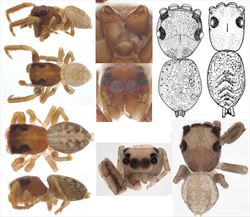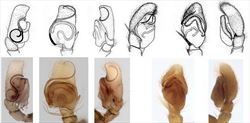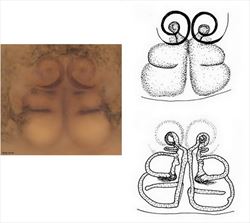
Examples of live Neon
Illustrator (and ©) I.R. Macaulay

Aspects of the general morphology of Neon
Illustrator (and ©) B.J. Richardson (CSIRO, MP)

Palp morphology of Neon taylori (L) and N. australis (R)
Illustrators (and ©) B.J. Richardson (CSIRO, MP)

Epigyne morphology of Neon taylori
Illustrators (and ©) B.J. Richardson (CSIRO, MP)
Neon Simon, 1876
Taxonomy
Neon is a widespread genus found in Europe, Africa, Asia and North America, as well as Australia where there are two species, Neon australis and N. taylori, as well as other undescribed species (Richardson unpubl.) Molecular data seems to link Neon to a large Australasian clade including Myrmarachne, Mopsus and Astia (Maddison 2015, Maddison et al 2008). Further information on the genus and described species can be found in Richardson and Żabka (2017) and Whyte and Anderson (2017).
Description
Neon spp. are very small spiders, body length 3 mm, with an ovate abdomen. The head, viewed from above, is short and wide, widest at or just behind the posterior lateral eyes. These eyes may or may not overlap the sides of cephalothorax. The carapace is high, with a curving surface rising to a peak at the posterior lateral eyes and then dropping sharply to the rear. Chelicerae have a single (unident) retromarginal tooth and either one or none on the promargin. The first legs are longest, the fourth legs next longest. In N. australis, unlike N. taylori, the first legs are very strongly fringed.
The male’s palp has a short tegulum with a proximal lobe. In N. australis, the long, thin embolus begins with an anticlockwise spiral on the prolateral side of the palp. It then passes across the distal edge of the tegulum before moving further distally to finish in a partial anticlockwise spiral near the tip of the cymbium. In N. taylori the long, thin embolus arises on the posterior lateral margin of the tegulum and passes across the top surface of the tegulum. The palpal tibia in both species has a single, short, sharp retro-lateral tibial apophysis.
The female has two epigynal atria with C-shaped or spiralling sclerotised guides anterior to the spermathecae. Short insemination ducts enter the anterior edge of multi-chambered spermathecae located close to the epigastric fold.
Biology
These small spiders are quite common in litter in forests and woodlands.
Distribution
Various undescribed species have been found throughout Australia indicating that Neon occurs from the highlands of Tasmania, in temperate mainland forests, across hot, dry inland areas, and through the subtropics to the wet tropics.
References
Maddison, W.P. 2015. A phylogenetic classification of jumping spiders (Araneae: Salticidae). Journal of Arachnology 43, 231-292.
Maddison, W.P., Bodner, M.R. & Needham, K.M. 2008. Salticid spider phylogeny revisited, with the discovery of a large Australian clade (Araneae: Salticidae). Zootaxa 1893, 49-64.
Richardson, B.J. 2013. New unidentate jumping spider genera (Araneae: Salticidae) from Australia. Zootaxa 3716, 460–474.
Richardson, B.J. & Żabka, M. 2016. Salticidae. Arachnida: Araneomorphae. Canberra, Australian Faunal Directory. Australian Biological Resources Study, at https://biodiversity.org.au/afd/taxa/SALTICIDAE.
Whyte, R. & Anderson, G. 2017. A Field Guide to Spiders of Australia. CSIRO Publishing: Clayton.
* The information sheet should be interpreted in the context of the associated diagrams and photographs. Diagrams explaining anatomical terms can be found in the ‘Salticidae’ pictures at the beginning of the list of genera.